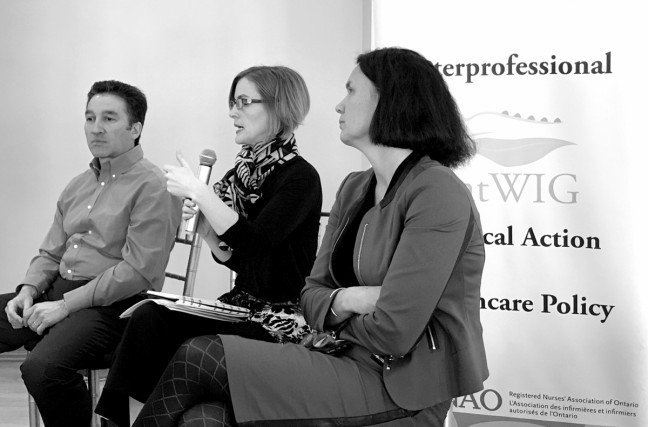Wound Care Quality Standards are the foundation for the Ministry of Health and Long-Term Care in Ontario (MOHLTC). The OntWIG symposium identified disconnects between the quality standards and practices around procurement, funding accessibility and inconsistencies in the continuum of care across the 14 Ontario Local Health Innovation Networks (LHIN).
Here we reflect on the thought-provoking Ontario Wound Interest Group (OntWIG) symposium that examined the adoption of the Health Quality Ontario quality standards covering diabetic foot ulcers, pressure injuries and venous leg ulcers.
Quality Standards
The Wound Care Quality Standards are a set of statements from Health Quality Ontario that describe what high-quality care looks like across the Ontario health system. They are based on the best available evidence, such as the RNAO Best Practice Guidelines for Pressure Injuries. Each quality standard addresses an area where there is currently a high variation in care in the province and where data demonstrates that there are opportunities for improvement.
Diabetic Foot Ulcers – Care for Patients in All Settings
Pressure Injuries – Care for Patients in All Settings
Venous Leg Ulcers – Care for Patients in All Settings
Health Quality Ontario recognizes that achieving the vision for high-quality care outlined in the quality standards requires improvement at the local organisational, regional, and system levels. These are defined by HQO as:
- At the organizational level, the quality statements and related indicators can be used as resources to make improvements to care.
- At the regional level, the quality standards can be used to set and guide collaborative improvement with the LHINs. Regional quality tables and clinical quality leads can help drive this process.
- At the system level, the quality standards can be used to determine the types of changes and improvements that may need to support the delivery of high-quality care across the Province. HQO has developed recommendations for adoption based on consultation with key stakeholders and front-line providers on how to address the system level issues.
An important milestone was announced by MOHLTC in November 2017 that provided funding to Local Health Integration Networks (LHINs) and Aboriginal Health Access Centres for total contact casts. There remain DFU recurrence post TCC through the gaps in funding for follow-up maintenance.
The University of Wales, Cardiff, UK has been the first jurisdiction to create wound care as a medical speciality.
Recommendations for Adoption of the Quality Standards
Here we have taken the Diabetic Foot Ulcer by way of illustration of the Quality Standards. The key documents include:
- Diabetic Foot Ulcer Quality Standard
- Recommendations to enable widespread adoption of the Diabetic Foot Ulcer quality standard
- Getting Started Guide: Putting Quality Standards Into Practice – A guide designed for people who are interested or involved in using quality standards to improve care.
The Recommendation for Adoption for DFU highlighted common themes that included some equity issues.
i) The disparity in the quality of services among jurisdictions and sites across the province, putting First Nationa, Inuit and northern and rural populations at a significant disadvantage.
ii) Variability in access to specialist services among jurisdictions and sites across the province.
iii) some groups are more at risk for developing wounds (e.g., individuals with limited or impaired mobility, individuals with neurological disease or injury, individuals with diabetes, older adults).
The Recommendation for Adoption for DFU identifying 20 recommendations covering:
- Integrating the quality standard into practice
- Quality improvement
- Access to care
- Coordination of care
- Education and training
- Policy and system planning
I-D-E-A-S system of improvement
IDEAS (Improving & Driving Excellence Across Sectors) is a training program focused on quality improvement. It’s designed for all healthcare professionals in Ontario – both emerging and established. Joe Mauti, Quality Improvement Advisor at Health Quality Ontario, presented the science of improvement noting three critical success factors; Will, Ideas and Execution. Mr Mauti emphasized the repeated test cycles to drive improvement.
“We don’t implement, we test,” encourages Joe Mauti
The differential between the science of improvement and innovation also echoed Dr Zayna Khayat’s comments noted in our Patients Included post from Toronto Health Innovation Week.
“All healthcare professionals have two jobs at work. One is providing care; the second is improving care.”
He noted that application is difficult before describing the System of Profound Knowledge work postulated by W. Edwards Deming. Four exemplars were presented on implementing Health Quality Standards for wound care, using the new IDEAS quality improvement framework.
“Special thx to Valerie Winberg and Laura Teague for their relentless commitment to improving wound care. Am pleased to be back with ON Wound Interest Group celebrating 10 years at their meeting to improve care and implement @HQOntario quality standards,” wrote Lee Fairclough, Vice President, Quality Improvement on Twitter.
DOWNLOAD HEALTH QUALITY STANDARDS
Look out for our next post on the Health Improvement Program Hackathon in Ottawa this coming weekend called #HIP613.
Featured image l-r Joe Mauti, Amy Olmstead, Director Home and Community Care, MOHLTC and Lee Fairclough

